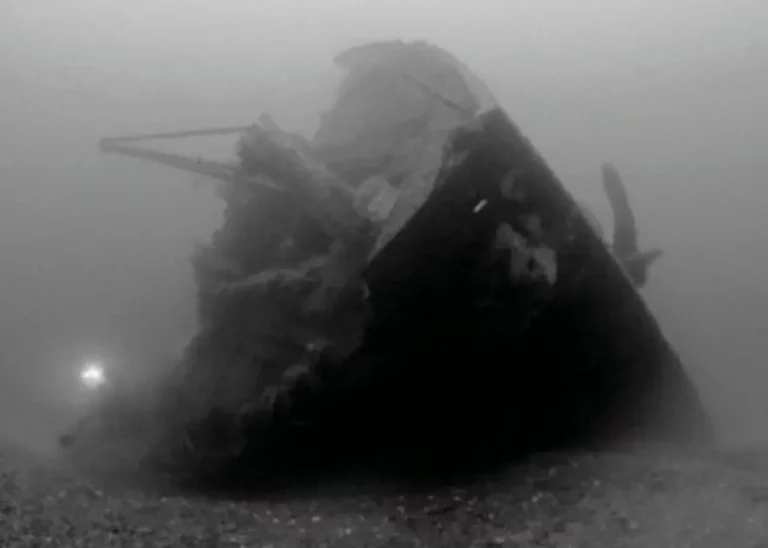A few months back, we found out what its like to dive the 125m-deep Transylvania.
Now technical diver Barry McGill goes looking for seldom-dived and lost shipwrecks in the same area off north Donegal – including another White Star liner, Carinthia.
THE NORTH COAST OF IRELAND gives divers the opportunity to dive hundreds of wrecks in some of the best visibility available in the northern hemisphere.
Many of these wrecks are either undived or have been visited only by a handful of people. So the area has become one of the worlds most sought-after locations for technical divers.
Last August, a small group from all over Ireland assembled with the aim of diving as many unknown or seldom-dived wrecks as possible in a week.
On the Friday evening, the gang started to arrive in the small village of Downings in northern Donegal.
In the local pub the conversation revolved around which wrecks to target.
By the end of the evening, our objective for the following day had been decided. All we needed was the weather, but it didn't look too favorable.
That first day of diving was an anti-climax, as the small weather window at first light slipped away.
Nobody fancied doing decompression in worsening conditions on the first day of a long trip, so the day was abandoned.
But the following morning the diving finally got off the ground, with a nice warm-up on the Roscommon.
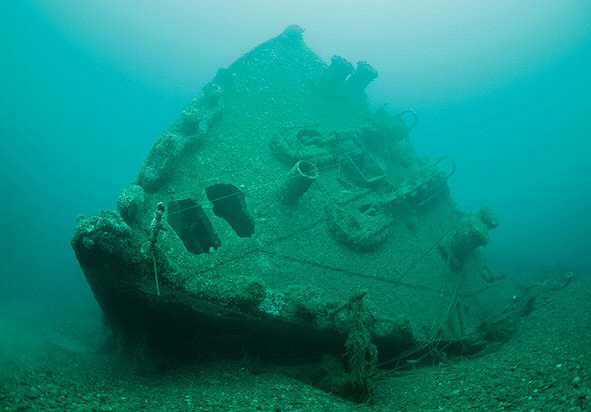
This 8238-tonne steamship, owned by the Union Steam Ship Co of New Zealand, was part of a convoy when it was sunk by U53 on 21 August, 1917. The wreck lies in 77m in visibility of up to 20m, allowing great views of the bow.
Roscommon was outward-bound from England in convoy when she was torpedoed in no 3 hold, so there is a very varied cargo of bottles, tiles and even millstones to be examined.
Few of us had dived the wreck before, and it ramped up our existing excitement about the trip.
Michael McVeigh, skipper of our charter-boat Rosguill, had a very special trip lined up for the Monday morning – the wreck of the British submarine HMS D6, which sank on 22 June, 1918.
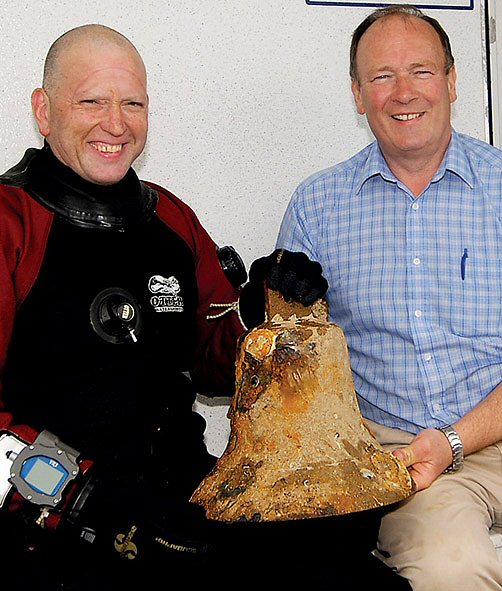
Most of the group had dived many of the WW2 Operation Deadlight U-boats that litter the seabed off the north coast, so the opportunity to dive a British submarine lost in the heat of battle, and one of the few diveable British submarines in the world, made everyone eager to hit the water.
D6 is the only diveable British submarine in Irish waters, and her loss was one of those rare instances of a submarine sinking another sub during WW1.
Sent to a waiting station off the north coast, D6 was to track down and destroy UB73, which had been causing havoc in the area.
The plan was to lie in wait, but UB73 was already present, spotted the British sub at the surface, and torpedoed and sank her with no survivors.
Sadly, the wreck did not want to give us any of her secrets. At the bottom of the shotline in 90m all we saw was sand, and our limited bottom times made a major search of the seabed impossible.
Maddeningly, we still ended with a 100-minute return to the surface.
The first divers up caused an incensed skipper to jump around when he heard that his shot hadn't held in a wreck more than 40m long and 1.5m off the seabed!
WEATHER AGAIN PLAYED A PART the next day when we were forced closer inshore, to the wreck of HMS Audacious.
This is one of the three most sought-after wrecks to dive off the north coast, and again, good visibility afforded us the impressive sight of this once-great Dreadnought battleship rearing over the gravelly seabed.
The first major warship casualty of WW1, Audacious was part of the 2nd Battle Squadron.
On 27 October, 1914, she was part of a fleet in line ahead preparing to engage in target practice when she struck a German-laid moored mine on the port side.
She tried to reach Lough Swilly in very rough seas while filling with water, and was taken in tow by the White Star liner Olympic, which took off her crew.
The line parted several times, however, even after a small collier attempted to assist.
By the time the battleship Exmouth arrived the main deck was awash, and eventually Audacious blew up and sank. The Admiralty was concerned that a single mine could sink a battleship.
The wreck lies in 63m, its triple screws showing on the capsized hull.
The target for Wednesday was a return to D6, but there was a strange air of trepidation on the boat as the team geared up.
Two divers with scooters would enter first and secure the shotline into the wreck. If needs be, they would be able to cover more ground to find the wreck and lay a bottom line for the rest of the team to follow.
They splashed in, and the long wait began. Then the news we wanted to hear came over the comms system – they had located the wreck.
Michael positioned the boat and gave the go-ahead for entry. Within seconds, divers were falling over the gunwale rail and into the water. The deck had never emptied so quickly.
At the bottom, it became clear that we were not diving a U-boat. The British D-Class submarine is very different in design to her German counterpart. In particular, the two bow torpedo tubes are mounted directly over each other.
The wreck was very low to the seabed, with the conning tower partly detached and lying to the port side.
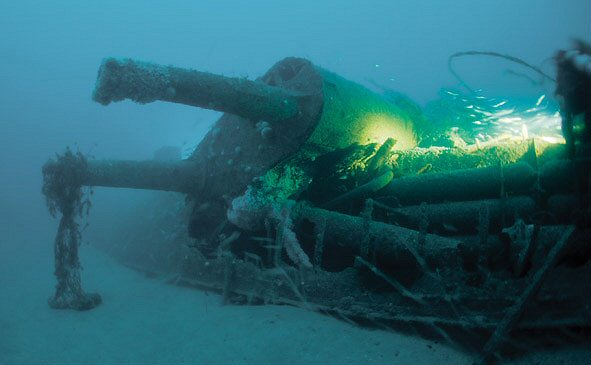
The conning tower appears to have been damaged by fishing nets, which has opened up the control room.
This allowed clear access to view deep inside the area directly below the conning tower. This is a beautiful section of the wreck, with lots of brass gauges still visible.
The view provides an insight into the cramped conditions in the submarine when it was in service.
D-Class submarines have forward hydroplanes that are massively over-sized in relation to the vessel as a whole.
They look almost like giant paddles. Other distinctive features include the shafts running along the top of the hull from the conning tower.
These rotate to open and close the forward and aft torpedo tubes.
Returning from the stern along the starboard side of the wreck, a large void on the side of the hull indicated the torpedo damage that sank D6.
This time-capsule effect is one of the most exciting aspects of diving such wrecks.
THE WEATHER FORECAST GAVE THURSDAY as the best weather window for the weeks activities, so an early-morning start was in order.
Our skipper had a mark that had been preying on his mind for some time. The hint of a possible large, undived mark revitalised the team, and everyone found it hard to sleep that night.
We set off on a 110-mile round trip to dive 30 miles west of Bloody Foreland. The target was thought to be the wreck of the Cunard White Star liner Carinthia, a 183m, 20,000-tonner hired by the Admiralty at the start of World War Two as an armed merchant cruiser fitted with eight 6in, and two 3in guns.
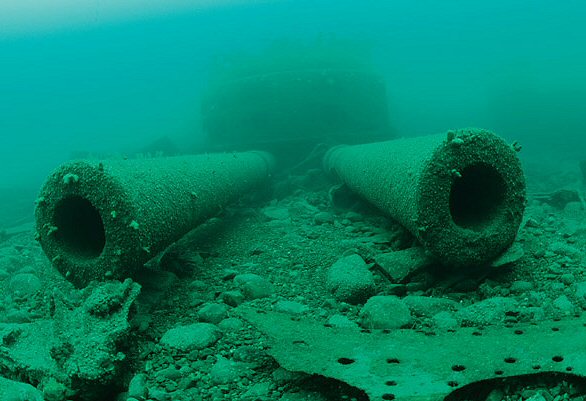
Carinthia was torpedoed by U47 on June, 1940, and sank a couple of hours later while under tow to Glasgow, 34 miles west of Bloody Foreland. All crew except for two officers and two ratings killed in the initial attack were rescued.
None of the divers was ready for what they would experience on entering the water out of sight of land.
Descending the shotline through the slightly murkier surface waters, we broke through the thermocline at 48m to see the massive intact wreck.
This incredible sight was amplified in the 50m-plus visibility, with natural light penetrating from the surface to the wreck, which lay in 117m.
The Carinthia is collapsing to starboard, with the decks mostly level. Touching down after a long descent on the port side of the ship and seeing the massive hull stretching out in both directions with its countless rows of portholes was extraordinary.
I MOVED ALONG THE PORT GUNWALE rail towards the bow. The seabed along the starboard gunwale rail was littered with items from the great ship.
I could see the bridge telegraphs and compass housing spread across the seabed.
The bow lies on its starboard side, revealing the massive port anchor securely in place. The bow section was the highlight of the dive, because it offered a real appreciation of the huge size of this magnificent ship.
But my bottom time was running out, and I had to drag myself back towards the shotline. On the way, the forward mast appeared, sprawled over the seabed and mostly intact.
Fantastic reports kept coming back from divers astonished by the landscape of the wreck.
Artefacts litter the decks and the seabed on the starboard side, including brass telephones and ships logs. Memories of this great dive will stay with everyone for years to come.
We woke battered and bruised from our long day at sea. The weather window had passed, and we would again be limited to a closer inshore wreck – the dependable HMS Audacious.

We made the most of the relatively long bottom times achievable on this wreck, with most divers enjoying 35-45 minutes and able to capture some great video and photographs.
The sea conditions did not improve overnight, though our spirits remained high, because most divers relished the opportunity to spend even more time on Audacious.
And one diver was very pleased with himself, after locating a brass firing trigger in the shape of
a pistol from one of the 4in casement guns. He had spotted it while viewing the previous days video footage!
On our final day, Sunday, everybody hoped for another chance to go further offshore, and Michael prepared for the long journey back to the Carinthia.
Visibility on the wreck had reduced to 15-20m, so it was a lot darker this time round, but the identification of the liner was put beyond any doubt after the bow bell and mast bell were both recovered, capping our expedition perfectly.
The Carinthia is one of the greatest shipwrecks any of the divers on this trip had been privileged to dive.
Arriving back at the boat yard in Downings, it was clear that no one wanted to leave. Everyone agreed that the unexplored areas of the north coast would have to be visited again.
Few locations can rival the potential for virgin wreck diving off the Irish coast.
RosGuill is a 13m Aquastar based in Downings, Donegal, visit RosGuill website.
